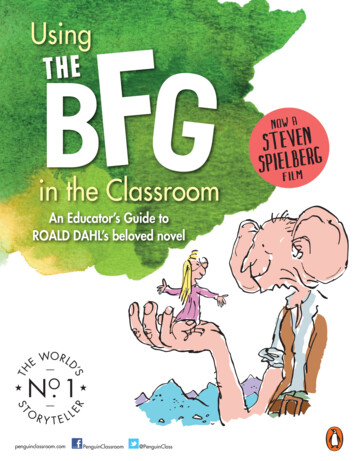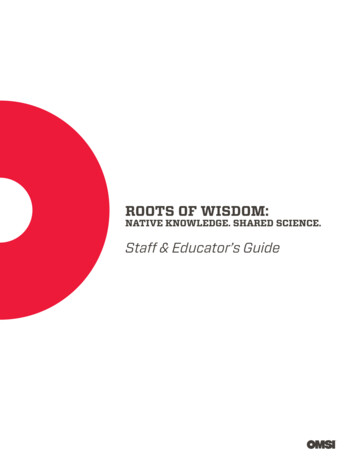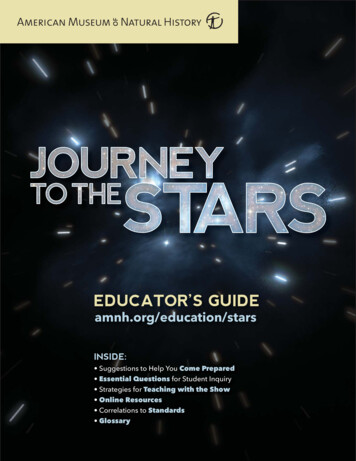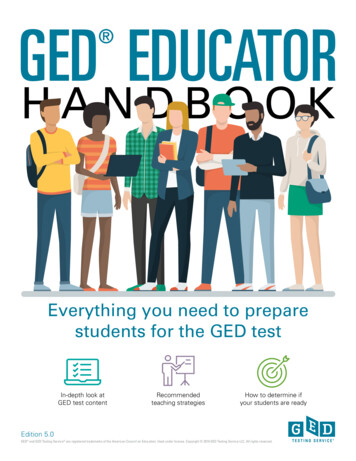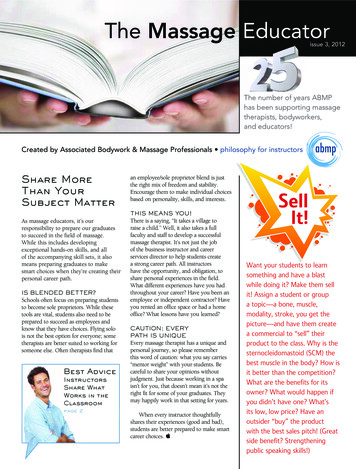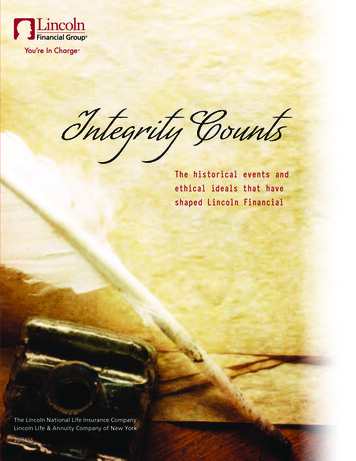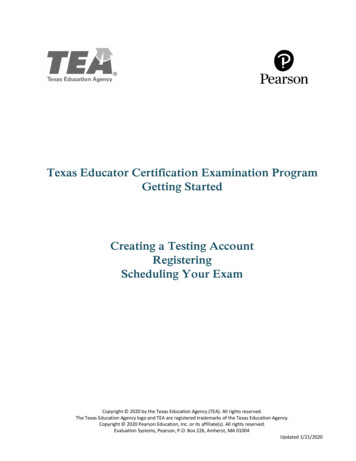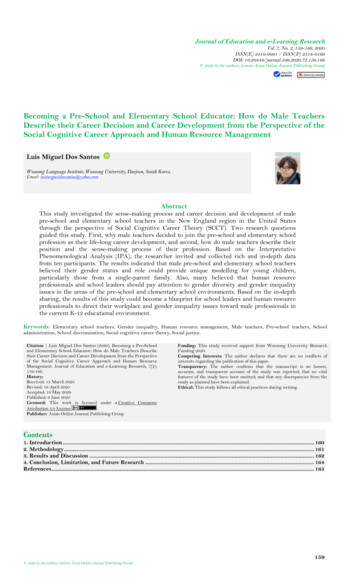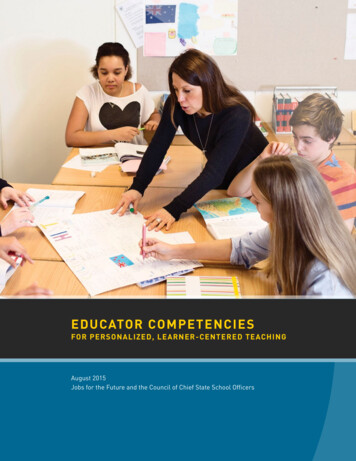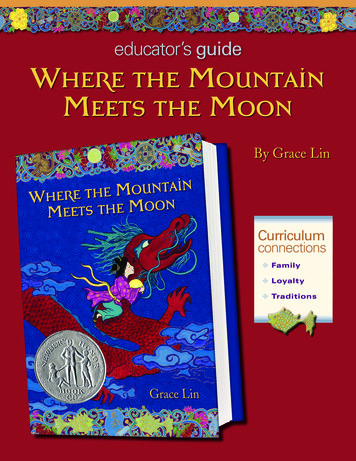
Transcription
educator’s guideWhere the MountainMeets the MoonBy Grace LinCurriculumconnectionsD FamilyD LoyaltyD Traditions
Research in Practice: QuestioningQuestioning is a skill and strategy that helps readers gain a deeper understanding of a book.It can take the form of predicting what will happen next, pondering why a character mightchoose a particular action, or be an inquiry about an author’s motivation to write a particularbook. At its simplest level, it can elicit a brief summary of events in order to help readers assesstheir literal understanding. At its most complex, it can help readers make strong connectionsthat lead to personal revelations. Questioning is at the heart of comprehension.Discussion Guide:Chapters 1-3Jade Dragon’s children do not want to disobey theirmother, but they want to save the people. What dothey do? Is this an act of disobedience?Why or why not?Minli writes a letter to Ma and Ba, and she signsit “Love, your obedient daughter.” Is Minli beingdisobedient? In what ways are her actions similar ordifferent from the actions of Jade Dragon’s children?Why does Minli buy the goldfish? What does shehope will happen?As Minli left the house on her journey, nobodyseemed to notice her leaving. What does this tellyou about where she lives? What conclusions canyou draw?Stories are an important part of Minli’s life. Whatdoes Ma think about stories? Why do you think shefeels this way?As Minli sets off, following the needle in her bowl,she says goodbye to Jade Dragon. Why do you thinkshe does this?Ba tells the story of how Magistrate Tiger tried toarrange his son’s future by outsmarting the OldMan of the Moon. In some ways Magistrate Tigersucceeds, but he also fails. Explain how he bothsucceeds and fails. What does his son think ofhis actions?Chapters 7-9Chapters 4 - 6Ma and Ba see footprints and a line in the dirt thatthey think might lead them to Minli. Do you thinkthese footprints belong to Minli? Why or why not?Minli decides to release the goldfish into the river.Why did she make this decision? Do you think itwas a good decision? Use evidence from the story tosupport your answer.When Ma and Ba discover Minli is gone, they reactin different ways. How does Ba react? How doesMa react? Use details from the story to explain youranswer. Be sure to explain what is meant by, “Herwords cut into Ba like slices from a knife.”Minli hears a strange sound. Her curiosity makes herforget about her thirst. How do you think Minli feelswhen she discovers what is making the sound? Howwould you react if you were in Minli’s place?What did Ma and Ba discover when they followedthe noise in the forest? How do you think they feltwhen they discovered this person?The author uses a writing technique that involveschanging perspectives between chapters. Why doyou think the author chose to do this? How does ithelp the reader draw connections between and amongcharacters? How does it add suspense to the story?2
Chapters 10 -13After Minli tells the dragon her story, she invites himto come with her to see the Old Man of the Moon.What does the dragon hope to learn from the OldMan of the Moon?Minli asks the dragon his name, and he tells her hisstory. Minli learns that he was painted without eyesand on the ground instead of in the air. The artistsaid, “Perhaps the Magistrate will see how his wealthweighs him down.” What do you think he meant bythis statement?After Dragon finishes his story, he seems sad that heis not a “real” dragon. Minli tries to cheer him up bysaying that he feels real to her and they can at least bereal friends. What does it mean to have a real friend?What qualities do you look for in a real friend?When Ma and Ba encounter the goldfish man,they tell him they are looking for Minli. Whenhe suggests that Minli might achieve her goal ofreaching Never Ending Mountain, both Ma and Basay it is impossible. The goldfish man gazes at themand makes them feel “like freshly peeled oranges.”What does this mean? How did Ma and Ba feel?Why would they feel this way?In the story told by the goldfish man, Ma and Balearn that he once read from the Book of Fortune.If you had the chance to read from the Book ofFortune, would you do it? Why or why not?Minli and Dragon hear the cries of the monkeys.As Minli looks around, the monkeys appear to beeverywhere. Dragon asks what they are going to do.If you were Minli, what would you do? Consider thelist of items Minli packed. How would you use theseto develop a plan?Chapters 14 -16Minli uses the items she brought with her in a cleverway. Describe how she outsmartes the monkeys.How did her memory of the children fighting overmud pies help her think of this idea? Was this similarto the plan you developed?As Ma and Ba think about whether or not theyshould let Minli try to change their fortune, Ba saysit is like trying to find the paper of happiness. Inthe story he tells, the secret of happiness is shared,but it is lost. What do you think was written on themissing paper? What one word might be the secret tohappiness? Why do you think this?Minli and Dragon meet a fish that thinks Dragonmight be its Aunt Jin. The fish then tells a storyabout the Dragon Gate. Why does Minli think shemight have met Aunt Jin?Chapters 17-19When Minli meets the Buffalo Boy and is taken tohis home, she feels a tightness in her throat whenshe thinks of her home in contrast to the boy’s home.What does she have that Buffalo Boy does not have?What does Buffalo Boy have that she does not have?Buffalo Boy tells the story of his friend. What is hisfriend like? Who do you think she might be?Chapters 20 -23Ma offers to carry the goldfish and she feeds thegoldfish from her own rice bowl. In what waysdoes Ma seem to be changing? What has causedthis change?Minli offers the Buffalo Boy her last copper coin, buthe does not take it, even though he is very poor. Whydoes the Buffalo Boy tell Minli he does not need it?Minli uses the coin to purchase a peach. Whathappens to the peach she buys? How does this act ofkindness help her reach her goal of finding the king?The king tells Minli a new version of the Old Manof the Moon story. In this version, Minli learnsthat Magistrate Tiger tore a page from the Book ofFortune. The king guesses this page might be the3
“borrowed line” Minli is looking for on her journey.The message on the page changes depending on thesituation. What does the message say as the kingreads it to Minli? What do you think this means? Useexamples from your own life or other books you haveread to explain your answer.Chapters 35-39Chapter 24 -26After Dragon is well again, it is time to continuetheir journey. The people of the Village of the MoonRain make Minli a warm coat. What do they use tomake this coat? Why is this gift an example of truegenerosity?Dragon also believes he has discovered the borrowedline. Why does he think he has the borrowed line?Where does he get this string?When Minli meets Dragon they each share theirstories, but they conclude they will have to ask theOld Man of the Moon to determine which one ofthem has the real borrowed line. Given what youknow from the story, which one do you think isthe real borrowed line? Support your answer withevidence from the story.Chapters 27-29Minli and Dragon encounter a tiger, but it is notan ordinary tiger. How does the author describe thetiger? What word choices help you visualize the tiger?When Minli realizes Dragon is badly injured,what does she decide to do? Why is this a difficultdecision?Chapters 30 -34Minli hears a young girl tell a story to the GreenTiger. What story does she tell? How does thisstory help the girl defeat the Green Tiger?When Minli enters the village with A-Fu andDa-Fu she is told the story of how the village got itsname. Why is it called the Village of the Moon Rain?4After Minli rests, she has the opportunity to hearmore about Green Tiger. What does she discoverabout the origins of the Green Tiger? How do thevillagers discover the tea used to cure the tiger’spoison?On the journey, Minli and Dragon hear the story ofDa-A-Fu’s ancestors. How does this story help youunderstand an earlier story in this book? Why do youthink the Old Man of the Moon moved their home?When Minli and her traveling companions arrive atNever Ending Mountain, it seems too far away forthem to reach. What idea does Minli put intoaction in order to get a message to the Old Manof the Moon?When Minli suggests Da-A-Fu could ask the OldMan of the Moon how to change their fortune, theylaugh. Why do they laugh? Does this remind youof the reaction of any other character in this book?Which character? How is this character similar anddifferent from Da-A-Fu?Chapters 40 - 43Ba tells Ma they are like “the dragon waiting fora sign of his pearl.” After reading the story aboutthe dragon’s pearl, explain what Ba meant by hisstatement.
After Minli crosses the bridge on her own, sheencounters the white rabbit. The rabbit tells her thestory of Wu Kang. What lesson does the Old Man ofthe Moon hope to teach Wu Kang? What lesson canyou learn from Wu Kang’s story?Minli is faced with a difficult decision when shereaches the Old Man of the Moon. She can only askone question. What question does she ask? Why doesshe ask that question? What details in the story helpyou understand her decision?Chapters 44 - 46Ma finally tells her own story. How does her storyshow how she has changed from the beginning of thebook? What is different now?When Minli returns to Dragon, she is able to showhim why he can’t fly. What does she do?When Dragon discovers Minli sacrificed heropportunity to ask her own question in order to askhis, he wants to fly her back to the Old Man of theMoon. Minli replies that she does not have to askthe question because she already knows the answer.She realized fortune and gold do not make a fortune;it is something else. What does Minli mean? Do youagree with her? Why or why not?On the way back home, Minli and Dragon seeanother dragon. Minli thinks the dragon looksfamiliar. Why does she think this?Dragon begins to act a bit strange. He seemsreluctant to leave Fruitless Mountain, and Minliagrees to walk home from there. Why do you thinkhe was acting this way? Why do you think he said hefelt he was home?Chapters 47- 48When Minli returns to her home, Minli and herparents discover several different types of goodfortune. What good fortune do they discover?Which of these is the most valuable of all to Minliand her parents?Compare and contrast the Village of FruitlessMountain from the beginning of the book with theVillage of Fruitful Mountain at the end of the book.In what ways are they the same? In what ways arethey different? How do the illustrations reflectthe change?Reflection:Ma said stories were worthless, but stories play animportant role throughout Minli’s adventure. Usingexamples from the book, how did stories help Minliand others reach their goals? How did stories helpcharacters change and develop throughout the book?Do you think stories are important?5
Building BackgroundSchema SketchWhere the Mountain Meets the Moon is a fantasystory, but it takes place in China. To help studentsunderstand the setting, ask students to think aboutwhat they already know about China, and then createa “schema sketch.” A schema sketch is a drawingthat allows students to show what they alreadyknow. Share pictures or other stories about China.As students expand their knowledge, have them addto their sketch using different colors. After readingWhere the Mountain Meets the Moon, ask students tocreate a new sketch or add to their original sketch in abrand new color. Was the setting similar to what theypredicted? What was the same? What was different?PredictingBefore, During, and After ReadingMinli places a number of items in her blanket tobring on her journey. She packs a needle, a pair ofchopsticks, her white rabbit rice bowl, a small pieceof dried bamboo, a hollow gourd full of water, asmall knife, a fishnet, some uncooked rice, a largepot, and one copper coin. List all of the items andhave students predict how she might use each itemon her journey. Which item do they think will bemost important? As students read, have them referback to the list and record how Minli really used eachitem. After reading, ask students to reflect on theiroriginal predictions. Were they surprised by the waysthe items were used? Is it possible to determine whichone was most important? Why or why not?VisualizationKey MomentThe beautiful illustrations and artwork throughoutWhere the Mountain Meets the Moon allows readers tosee what the author imagined her words to convey,but not every scene is illustrated. After students finishreading the book, challenge them to pick one “keymoment” in the story, a part of the story that seemsto be a turning point or that captures the essence ofthe book. Brainstorm ideas as a class, then choosethree or four to illustrate. As a class, choose thevisualization that seems to capture the point of6the book the best. Display this on the wall of theroom. Use this same process with other books theclass reads, and there will be a visualization gallery toremind students of the incredible literature they haveexperienced.VocabularyVocabulary HuntGrace Lin paints pictures with her words, not onlythrough the use of figurative language, but withthe specific vocabulary words she chooses. Helpstudents make these words their own by giving themthe task of collecting vivid vocabulary words as theyread the book. Have students record the word, thepage they found it on, and how it was used. Createa class list of vocabulary words, then work togetherto categorize them. For example, many of the wordsused to describe the Green Tiger such as malevolent,malicious, and vicious might be categorized togetheras synonyms. Challenge students to use the newwords in their writing and conversation.Sensational SimilesCarefully crafted similes and metaphors are presentthroughout the story. Have students collect theirfavorite similes as they read the book, then vote onthe class favorites. Discuss why these similes andmetaphors are so effective. Then, give students theopportunity to create their own. Provide picturesfrom magazines or have students choose one of thepictures in the book. Finally, have them write severalsimiles or metaphors that might be used to describesomething in the picture.Making ConnectionsRed Thread ConnectionsGrace Lin refers to the Chinese legend describinghow the red threads connect people. In Where theMountain Meets the Moon these red threads make a
bridge leading Minli to the Old Man of the Moon.Discuss with students how connections to personalexperiences, other books, and background knowledgecan help them understand this book and other piecesof literature. Ask students to record their connectionsand observations as they read the book, or as theyread a particular chapter. On a piece of paper, havestudents write the title of the book or the chapter.Then, have them write their connections aroundthe book title. Use red yarn or string to visually linktheir experiences with the book title. After studentscomplete this individually, have them share theirconnections with the class. Did they have moreconnections to their personal experiences, otherbooks they have read, or what they know about theworld around them? How do these connections createa bridge of understanding? As an extension, studentscan write a written reflection.Connecting to CharactersHave students choose a character from the story.Ask students to identify the character’s attributesand share examples from the story that show theseattributes. Then, have students identify whichcharacter they are most like and give an examplefrom their life that shows how they are similar tothis character.WritingPersuasive WritingThroughout the story there are differing viewpoints.In the beginning of the story, Ma thinks stories area waste of time, but Ba thinks they are not. JadeDragon thought the people should be punished fornot appreciating her, but her children wanted to savethe people. These are just a few of the examples inthe book that show one point of view contrastedagainst another. Have students choose two characterswith differing viewpoints and write a persuasive letterfrom each character’s perspective, asking the reader toagree with their view.Author StudyGrace Lin is a gifted writer and illustrator. Havestudents choose other books of hers to read. Compareand contrast them with this book. In what waysare they similar? In what ways are they different?Have students compile a list of questions they wouldlike to ask the author. Use the library and Internetto discover the answers. For any that cannot beanswered easily, consider writing a class letter tothe author.SummarizingSelling the Setting: Minli RealtyHave students identify one of the various villages orsettings from the book and pretend they are realtorsattempting to sell the property to others. Whatare the highlights of this particular place? Whattype of person would be happiest here? If there arenegatives, how can they be turned into positives?Begin by showing examples of brochures realtorsmight use to advertise a property, particularly avacation property. A short mini-lesson on media andadvertising techniques might also be given. Then,working in small groups, have students create apresentation or brochure to “advertise” their property.Integrate technology by making this a multi-mediapresentation.Social Studies and ScienceImpossible DreamsMa scolds Ba and tells him that his stories makeMinli dream of impossible things. Ask students toresearch an invention in history or an achievementthat was once considered an impossible dream. Theymay want to research the invention of the airplane,laser, computer, or other technological innovation,or think about human rights gains. What wouldthe world be like today without the invention orachievement they researched? How has it changedthe world? Bind the papers together to create an“impossible dreams that became possible book.” Asan extension, have students sketch or describe oneof their own ideas that may seem impossible today.When they look back on it years later, they maydiscover it was not so impossible after all.Finding Your WayMinli is instructed by the goldfish to use the ricebowl, water, and bamboo, along with a piece of themountain, to make a compass. Give students theopportunity to create their own compass. Providestudents with a small bowl or pie plate, a piece of7
foam, cork, or plastic (something that will float), a needle,and a magnet. Have students rub the needle across themagnet (in the same direction) about 10 times. Then,place the cork or foam in the water, and place the needleon top. The needle should slowly turn and point north.Ask students to think about why this was helpful forMinli. What if they wanted to travel east? How wouldknowing how to find north be helpful? Would this type ofcompass be helpful on a ship or airplane? Why or why not?Have students research how compasses have changed overtime and report to the class on their discoveries.Art and MusicDragon DrawingsDragons are found throughout many different types ofliterature and depicted in the artwork of many cultures.Have students work together to research and identifysome examples. They should be sure to include historicaldepictions as well as present-day versions in cartoons orother books. Then, have them create their own dragonusing any medium. They should be able to identify howtheir dragon is similar and different from the dragons theyresearched. As an extension, they may want to comparetheir dragons to Dragon in Where the Mountain Meetsthe Moon.Story TellingThe art of story telling is important in Chinese culture.Stories are told orally, using the face and hands of thestoryteller to make the story more dramatic. They usefew props. Discuss with students or encourage them toresearch the importance of storytellers in Chinese culture.A list of stories consulted by Grace Lin are included inthe back of Where the Mountain Meets the Moon. Chooseseveral Chinese folk tales for students to read and retell.Encourage students to use their voices and movement oftheir hands to keep their audience engaged. After studentspractice, host a storytelling event. Students can drink teaand enjoy the dramatic productions of their classmates.As an extension, ask students to research storytellingtraditions in other cultures. Why are stories important?What is similar and different about Chinese storytellingcompared to storytelling traditions in other cultures?About the BookIn the valley of Fruitless Mountain, a young girl named Minli lives in a ramshacklehut with her parents. In the evenings, her father regales her with old folktales of theJade Dragon and the Old Man on the Moon, who knows the answers to all of life’squestions. Inspired by these stories, Minli sets off on an extraordinary journey tofind the Old Man on the Moon to ask him how she can change her family’s fortune.She encounters an assorted cast of characters and magical creatures along the way,including a dragon who accompanies her on her quest for the ultimate answer.978-0-316-11427-1F&P TAbout the Author/IllustratorGrace Lin is a graduate of theRhode Island School of Design.She is the author and illustrator ofthree novels and ten picture books,and the illustrator of nine more.She grew up in upstate New Yorkand now lives in Massachusetts.She received a Newbery Honor for her novel Where theMountain Meets the Moon.www.lbschoolandlibrary.comAlso byGrace LinHC 978-0-316-06000-4PB 978-0-316-06002-8AR 4.2 F&P QHC 978-0-316-11426-4PB 978-0-316-03361-9AR 4.6 F&P QEducator’s Guide Prepared by Jennifer McMahon.
him why he can’t fly. What does she do? When Dragon discovers Minli sacrificed her opportunity to ask her own question in order to ask his, he wants to fly her back to the Old Man of the Moon. Minli replies that she does not have
